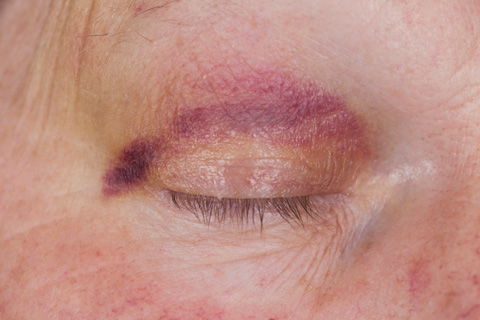Reduce Bruising with Vitamin K

Topical vitamin K has been promoted for treating varicose veins, skin redness, scalp rashes, and even rattlesnake bites. Despite some reports, there does not appear to be much research supporting most of these claims.(112-114)
However, there are clinical studies that corroborate the beneficial effects of vitamin K in treating bruised skin by applying vitamin K cream or gel.
Post-Treatment Bruising
Purple-colored bruising and purpura can occur as a result of pulsed dye laser (PDL) therapy or surgery. What forms of vitamin K can help?(111)
Vitamin K Cream and Laser Treatment
In several small clinical studies, application of vitamin K cream appeared to resolve the bruising and purpura much faster than placebo in study participants:
- Using a 1% vitamin K cream twice a day reduced healing time for bruising on forearms of 6 patients.(115)
- A cream combining 1% vitamin K and retinol resolved purpura caused by PDL faster than no treatment in 20 patients.(116)
Pre-treatment of patients having PDL therapy for facial spider veins with vitamin K cream did not prevent bruising. However, application of vitamin K cream after PDL treatment did accelerate the healing of bruises in 22 patients participating in a randomized, placebo-controlled clinical study. When compared to the side of the face treated with placebo, the vitamin K treated side had significantly less severe bruising.(32)
Vitamin K Oxide Gel
Vitamin K oxide gel, with the bioactive agent encapsulated in lecithin for greater skin penetration, may work even better than vitamin K gel. One study involving 10 blepharoplasty patients seeking to improve the appearance of aging skin around the eye compared vitamin K oxide gel applied to one eye with vitamin K gel applied to the other. The vitamin K oxide gel resolved the bruising around the eye much faster than the vitamin K.(117)
These results were further clinically corroborated in a randomized, double-blind, placebo-controlled trial involving 20 patients treated with PDL for spider veins on both sides of the face.(111)
Vitamin K oxide is the naturally occurring form of vitamin K after carboxylation — two steps further into the coagulation process than vitamin K. This may explain the faster resolution of any under-skin bleeding. As an active metabolite of vitamin K, vitamin K oxide is believed to be not only more effective, but a more stable and less allergenic substance than vitamin K.(111)
Vitamin K Oxide Cream
Vitamin K oxide cream may not work as well as the gel, at least with some laser treatments. A clinical study was designed to test the cream on purpura and pinpoint bleeding caused by Q-switched Nd-YAG 1064nm lasers.(118)
The laser was used on two different spots on participants' arms. One spot was treated with vitamin K oxide cream, the other with a 5% urea cream.(118)
The participants reported better and faster lightening results from topical vitamin K oxide cream on purpura. However, the researchers did not find the results to be significant. The vitamin K cream also caused some skin irritation as a side effect.(118)



